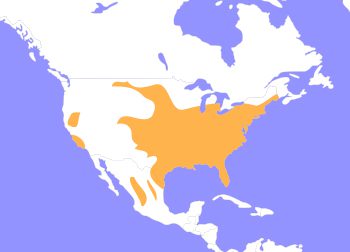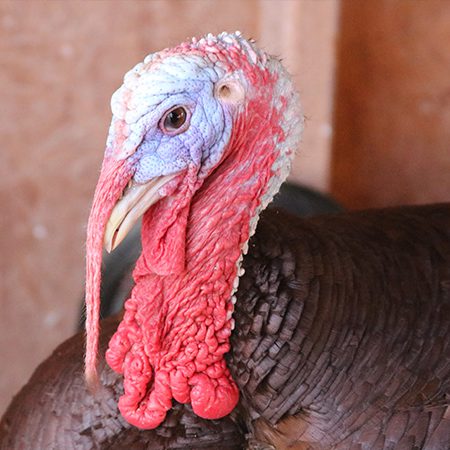Turkey
Meleagris gallopavo
Turkeys are an extremely common bird that is found only in the Americas, making them a New World bird. They are a very recognizable species due to their dark brown plumage and feather heads that can have bright red and blue colors. People can distinguish the sexes easily because the male has a whole bunch of extra skin hanging off his face. If it is from above the nose, that is called the wattle, whereas if it is from the chin, it is called the caruncle. They also can have beards and spurs on their legs. These characteristics are used to distinguish which males would make better mates (usually, the bigger the better). Females tend to be smaller and have duller feathers.
Turkeys are, obviously, used a lot in the food industry. Most of the turkeys raised for meat are white turkeys, whereas wild ones tend to be brown. Females can lay 4-17 eggs per brood and will care for them for a few weeks after hatching. These chicks are precocial, meaning they are able to walk and eat on their own as soon as they hatch. This is compared to altricial chicks, such as the American Robin, who are born sightless and featherless and need intense care for the first several weeks of their life. Because of their precocial chicks, the turkey is known to lay their eggs in the nest of another bird species to they do not have to care for them.

Turkeys are native to central and north America.
HABITAT -Mixed forests with the occasional open pastures.
DIET -They are omnivorous, eating nuts, seeds, leaves, and insects.
FUN FACT -Despite their fame on Thanksgiving, it was likely that deer was eaten at the first Thanksgiving instead.
SOCIAL BEHAVIOR -They will form bands during the winter and defend a territory.
ACTIVITY -They are diurnal, being active during the day, and do not migrate.
PREDATORS -Large carnivores prey on the adults while their eggs are eaten by smaller carnivores and snakes.
SIZE -Size varies with age and subspecies, can be 8-25 lbs.
RELATIVES -They are related to other game species, such as pheasants and grouse.
CONSERVATION -They are of Least Concern, according to the IUCN.
Cub Creek Animal Care Information
Housing - Our two turkeys are both located in separate Nursery stalls. They each share living space with other bird species. Though they are housed inside at night for their protection, during the day they are let out into a stall to allow some more place to explore.
Diet - Our turkeys are provided with a constant supply of game bird finisher feed, which provides them with all the nutrients they need to be healthy. Their enclosures also include Nelson water bowls that continuously provide fresh water for our birds.
Enrichment - Living in a multi-species enclosure provides our turkeys with enrichment daily. During the summer, campers can make puzzle boxes out of cardboard to make finding food a bit more challenging.


